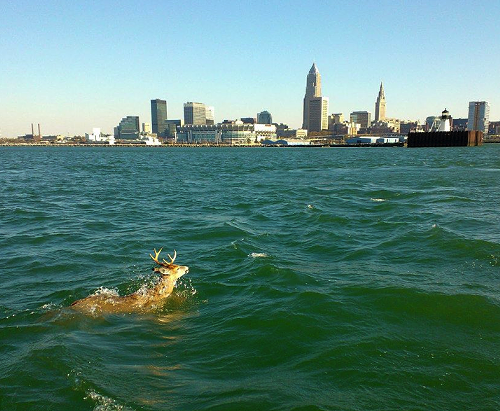
(H/t to Tom Hochbaum for the tip, and for the ideas on what to write about)
I was looking online for a picture of the garbage vortex in the south Pacific, and having a surprising amount of trouble. It’s this Texas-sized patch of garbage that, coming from the land and borne by currents, has been swirling and collecting for decades. It’s pretty famous, so I was kind of frustrated that I haven’t been able to find a good image of it, until I remembered: it’s the size of Texas.
How do you capture such an image? Have you ever seen a non-satellite photograph of all of Texas? Of course not. It’s impossible, just as it is impossible to imagine a garbage pile the size of that vast emptiness.
But it isn’t a fantasy. It is real. Even though the garbage patch is dwarfed by the enormity of the ocean, the idea that the waste of our civilization is gathering, and gathering size, is sobering and terrifying. Here are some horrible details.
The Patch is estimated to cover as much as 10% of the entire Pacific Ocean and it’s made mostly of tiny pieces of plastic that are the result of the process of photodegredation. Since plastic is non-biodegradable, it remains a polymer while the sun can only break it into smaller and smaller pieces. Once these pieces are small enough, fish and other aquatic animals mistake the plastic for plankton and ingest it. Even the plastic that isn’t eaten leeches harmful chemicals into the water, including pesticides, chemical byproducts, and toxic solvents. As a result, the plastics and chemicals that are consumed by the fish end up in our food supply. Delicious.
/https://public-media.smithsonianmag.com/filer/3b/4d/3b4d622c-f823-4e7a-8045-d3e14496c94b/credit-jennifer-lavers-east-beach-2-sm.jpeg)
This is Henderson Island. It is uninhabited.
It’s unsurprising that much of the waste is plastic. Plastic is a genuine miracle substance which has inarguably made life easier, but which lingers for centuries, choking our rivers and seas, filling our landfills, manifesting itself with hideous ocean-carried wreckage in the world’s most remote islands or as microplastics in the Great Lakes. Plastic bags flutter like ragged broken-spine scarecrows throughout the sky, catching themselves on trees and bushes, or drowning themselves in the sewers, soggy with a wordless permanence.
It takes thousands of years for plastic to break down. Which is why we’re so excited that there is genuinely great news about our addiction.
Scientists have created a mutant enzyme that breaks down plastic drinks bottles – by accident. The breakthrough could help solve the global plastic pollution crisis by enabling for the first time the full recycling of bottles.
The new research was spurred by the discovery in 2016 of the first bacterium that had naturally evolved to eat plastic, at a waste dump in Japan. Scientists have now revealed the detailed structure of the crucial enzyme produced by the bug.
The international team then tweaked the enzyme to see how it had evolved, but tests showed they had inadvertently made the molecule even better at breaking down the PET (polyethylene terephthalate) plastic used for soft drink bottles. “What actually turned out was we improved the enzyme, which was a bit of a shock,” said Prof John McGeehan, at the University of Portsmouth, UK, who led the research. “It’s great and a real finding.”
The mutant enzyme takes a few days to start breaking down the plastic – far faster than the centuries it takes in the oceans. But the researchers are optimistic this can be speeded up even further and become a viable large-scale process.
That’s absolutely astonishing. The natural evolution of an enzyme that can eat plastic is amazing enough, and shows the incredible flexibility of nature, which will eventually restore itself even if we kill ourselves off. It’s amazing that scientists could study its DNA, and tinker with it, and make it better, even if accidentally.
And it is just tear-inducing that they also think they can make it better. That they recognize a huge problem, have scoured the world to find a solution, and then, piece by piece, issue by issue, calculation by calcuation, they make it better. That they can use enzymes to offer hope in what seemed like an intractable problem.
That isn’t to say we should all start stocking up on plastic bottles and throwing them immediately away, because we’ve been saved. We should still strive to use as little plastic as possible, and recycle it as much as we can.
It doesn’t let us off the hook for the damage we have done, and continue to do. (Nor, I should state, is this a sure thing: there could be greenhouse ramifications, but that’s the best part of science. They’ll find out!) It doesn’t bring back the jetsam of our endless inventiveness.
It should still make you teeth-gnashingly angry, or at least frustrated and sickened, that we can wreak such havoc on such remote and unpopulated places, just by sheer dint of our material existence. And we’re all complicit. Lord knows I’m as guilty as anyone, through laziness and love of convenience.
But thankfully, there are a lot of people who don’t take “meh” for an answer. Thankfully, there are people who are working on mitigating and maybe even expiating our sins, and who can both invent new solutions and have the wisdom and flexibility to take advantage of happy accidents, of nature working in its own way to adapt to our impositions.
We aren’t saved. Nature doesn’t work quickly, which makes our outsized impact all the more stark. But it’s also true that our solutions are part of nature, since we are still, for all our inventions, part of nature. This odd and serendipitous partnership with a hungry enzyme might just be part of regaining that balance.









